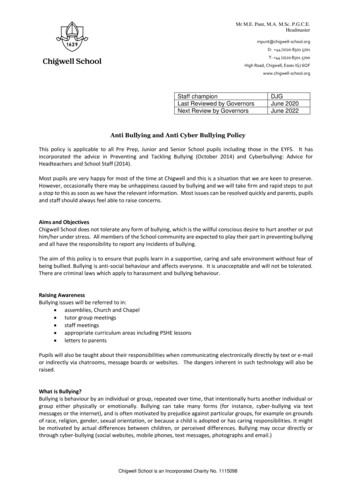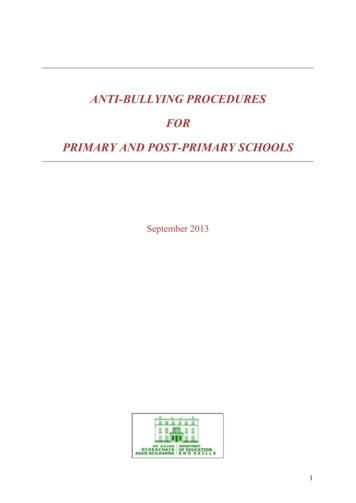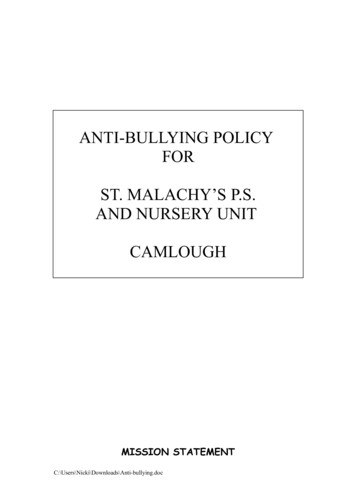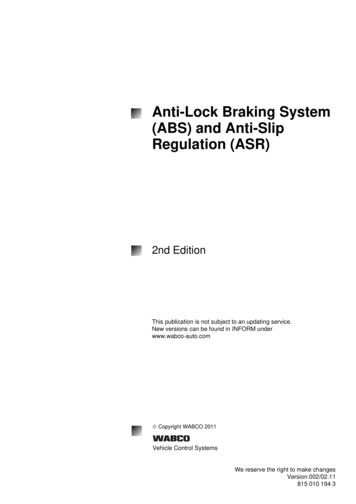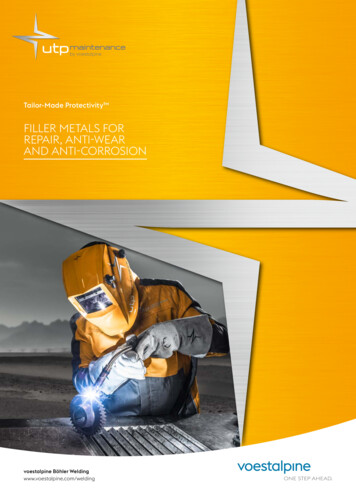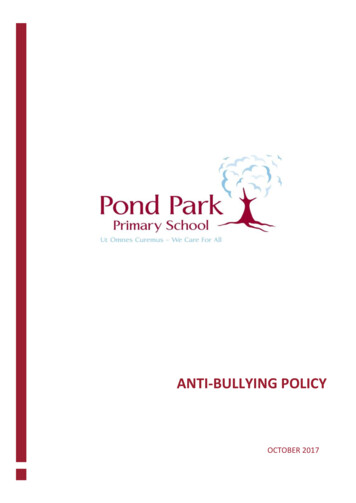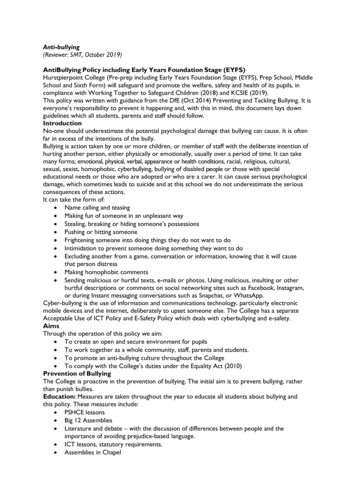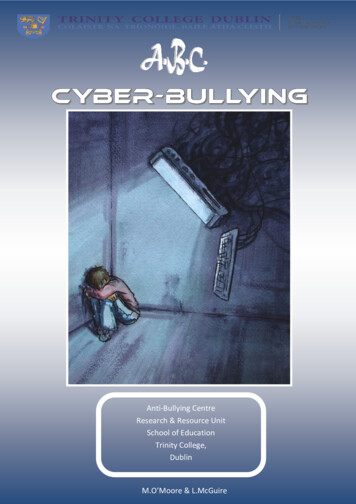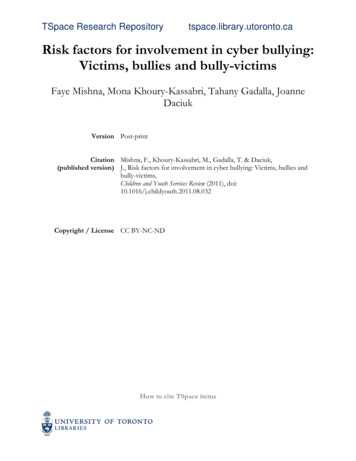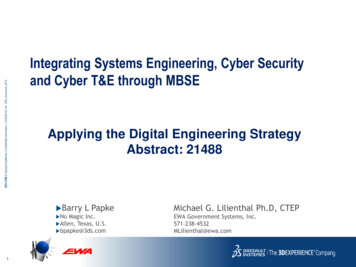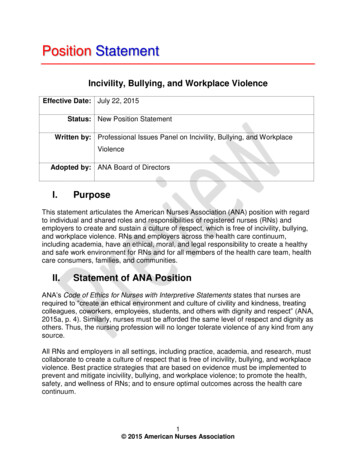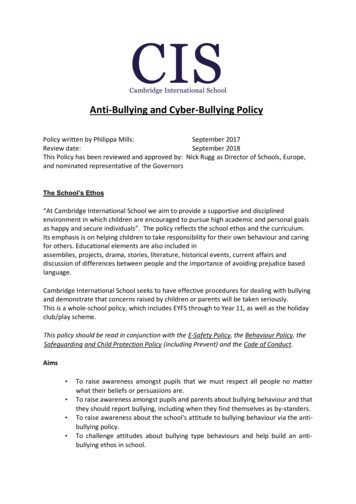
Transcription
Anti-Bullying and Cyber-Bullying PolicyPolicy written by Philippa Mills:September 2017Review date:September 2018This Policy has been reviewed and approved by: Nick Rugg as Director of Schools, Europe,and nominated representative of the GovernorsThe School’s Ethos“At Cambridge International School we aim to provide a supportive and disciplinedenvironment in which children are encouraged to pursue high academic and personal goalsas happy and secure individuals”. The policy reflects the school ethos and the curriculum.Its emphasis is on helping children to take responsibility for their own behaviour and caringfor others. Educational elements are also included inassemblies, projects, drama, stories, literature, historical events, current affairs anddiscussion of differences between people and the importance of avoiding prejudice basedlanguage.Cambridge International School seeks to have effective procedures for dealing with bullyingand demonstrate that concerns raised by children or parents will be taken seriously.This is a whole-school policy, which includes EYFS through to Year 11, as well as the holidayclub/play scheme.This policy should be read in conjunction with the E-Safety Policy, the Behaviour Policy, theSafeguarding and Child Protection Policy (including Prevent) and the Code of Conduct.Aims To raise awareness amongst pupils that we must respect all people no matterwhat their beliefs or persuasions are.To raise awareness amongst pupils and parents about bullying behaviour and thatthey should report bullying, including when they find themselves as by-standers.To raise awareness about the school's attitude to bullying behaviour via the antibullying policy.To challenge attitudes about bullying type behaviours and help build an antibullying ethos in school.
To raise awareness that hurtful behaviour in young children can develop intobullying in older children and that psychological damage can even result in suicide.To prevent pupils being subjected to radicalisation (as part of the Prevent duty ofall schools, following the Counter-Terrorism and Security Act 2015 – seeSafeguarding Policy and Anti-Terrorism Policy).To foster a positive caring atmosphere.To ensure good supervision in all areas of the school at all times so far as isreasonably practical, including off site visits and activities and holiday clubs/playschemeTo raise staff awareness by involving them in training.To talk openly about bullying with the children so that they can understand thefeelings of someone who is being bullied and learn to deal with bullying.Objectives All governors, staff, parents and pupils have an understanding of what bullying is.All governors, teachers and non-teaching staff know what the school policy is onbullying, and follow it when bullying is reported.All pupils and parents should know what the school policy is on bullying, and whatthey should do if bullying arises.Pupils and parents should be assured that they will be supported, and givenappropriate counselling, if necessary, when bullying is reported.Bullying is defined as behaviour, which is: Deliberately hurtful to others (physical, mental or through exclusion).Repeated over time.Difficult for those being bullied to defend themselves against such attacks.This includes racist, cultural, sexist and homophobic bullying, bullying on the basisof being lesbian, gay, bisexual or transgender, and cyber-bullying e.g. via mobilephones, text messaging, websites, photographs and e-mail, or disabilitydiscrimination.Because they are adopted or a carer.Frightening someone into doing something they do not want to do.Invading someone’s personal space to make him/her feel uncomfortable orunhappy.Taking or damaging someone’s property.Spreading rumours about someone.Behaviour by an individual or group, repeated over time, that intentionally hurtsanother individual or group either physically or emotionally. (Preventing andTackling Bullying, Advice for Principal Teachers, Staff and Governing Bodies, DfE,October 2014, p. 6)Cyber Bullying
Cyber bullying is perpetrated via a technological medium, e.g. using social media. It can bean extension of ‘face-to-face’ bullying, with technology providing the bully with anotherroute to harass their target. However, it differs in several ways from other kinds of bullyingbecause of the invasion of home and personal space and the size of the audience, and thatit can take place at any time of the day. It takes different forms:threats and intimidationharassmentcyber stalking, e.g. repeatedly sending unwanted texts, defamationexclusion or peer rejectionimpersonationcirculation of private information or imagesResearch into cyber bullying indicates that it is a feature of many young people’s lives.Cyber bullying can extend into non-school time. We advise parents to contact the police ifthis is the case. Cambridge International School should be informed of the details if theincident is likely to have repercussions in school. Cyber bullying, like all other forms ofbullying, should be taken very seriously. It is never acceptable. ResponsibilitiesEarly Years to Year 3Children are asked to Say "don't do that" / “stop” / “leave me alone” if someone does something theydon't like. Tell an adult, i.e. a teacher, classroom assistant, helper, lunchtime or aftercaresupervisor or parent if someone's behaviour is hurtful to them. To step in to help children in distress or tell an adult (i.e. not to ignore it).Parents are asked to Tell their child’s teacher or member of staff if their children are telling them abouthurtful behaviour in school.Staff will Record the incident and report it to the Principal, if children hurt other childrenthe school, having ascertained the full factsEnsure that perpetrators make a meaningful apology, and help children to planhow they can put things rightSanction them by taking them to the Principal or member of the SeniorManagement TeamMonitor the situation to prevent it happening again, bu supervising areas andtimes where incidents could happen covertly.Year 3 and aboveThe Anti-Bullying Reporting Chain
The victim should speak to a friend (a student volunteer may act as a mediator givingverbal information), who will then inform the Form Tutor. Alternatively, the FormTutor may be spoken to directly. All incidences are recorded (on a ‘Record of Incidentsof Bullying’ form, a copy of which will be held centrally by the Principal for monitoringpurposes and to evaluate the effectiveness of the approach adopted, or to enablepatterns to be identified. A further copy will be added to the pupil’s file.) Both thebullied and the bully are spoken to by the appropriate Form Tutor(s) and the Principalis informed. It should be made clear that the bully’s behaviour is unacceptable, anddependent upon the nature of the event, parents may be informed at a very earlystage. The victim must be aware that action has been taken against the bully, and theyare encouraged to develop strategies if they find themselves in similar situationsoutside the school. Vigilance is taken by staff members at all times, especially duringmovements between buildings and during lunch and break times.If incidences reoccur the parents will be invited to a meeting with the appropriateForm Tutor and Principal and the bully’s future within the school will be reviewed.The Principal and/or DSL have received training as to what constitutes a childprotection issue, as far as bullying is concerned, i.e. any bullying that puts the child atpersonal, mental or physical risk.The threshold for reporting a bullying issue to external agencies (e.g. police, socialcare) is known by all staff. This includes all issues where a child is at risk of furtherbullying, particularly outside the school area, or where the bullying involves a criminalact.Records of any incidents of bullying are kept centrally by the school to evaluate theeffectiveness of the approach adopted or to enable patterns to be identified. Thenumber of incidents is available for parents to be seen.Staff GuidelinesThe Bully Make the bully aware that their behaviour is unacceptable. Explain clearly and precisely what behaviour is causing distress to the victim. Discuss the difference between assertive and aggressive behaviour. Make the bully aware of the consequences if bullying continues. Discuss ways by which the bully must change their behaviour. Always inform the Principal. Monitor the bully’s behaviour over the next few weeks. Whatever the cause, bullying is usually a signal that the bully also needs help.Strategies Pupils are encouraged to talk to peers and teachers who can then give feedback.Teachers support in a confidential manner.All pupils undergo training into the effects of bullying and its prevention.Curriculum areas, such as English and Drama, provide opportunities to explorerelationships with bullying as the theme.
Creating an inclusive environment and a school, which builds on positive self-imageand commends good and appropriate behaviour in all areas and ages.Ensuring staff are trained on how to watch for signs, react to and deal with instancesof bullying or suspected bullying. This needs to include training on the needs of thepupils, including those with special educational needs or disabilities.Having comprehensive Internet security, with the appropriate filters.Teaching children how to stay safe in the online and real world.Senior Management, teachers and pupil groups regularly present ‘Anti-BullyingAssemblies’.Our key message will always be prevention, by teaching pupils that everyone in ourschool has the right to feel safe and happy, and that bullying of any kind will not betolerated.Exclusion *Parents may be required, during or at the end of a term, to remove a pupil, without refundof fees, temporarily or permanently from the school if, after consultation with a parent, thePrincipal of Section is of the opinion that the conduct of the pupil has been unsatisfactory.These sanctions will be imposed in severe or persistent cases of bullying.*The school will inform the local authority (where the child is resident) where a pupil'sname is going to be deleted from the admission register on certain grounds, e.g. when thechild has been taken out of school to be home educated, when the family has apparentlymoved away, when the child has been certified as medically unfit to attend, when the childis in custody for more than four months, or has been permanently excluded. The schoolrecognises that it must do this as soon as the grounds for deletion are met and in any eventbefore deleting the child’s name. (Regulation 8(1)(d),(e),(g),(i) and (m) and12(3) of TheEducation (Pupil Registration) (England) Regulations 2006, and see also KCSIE 2015).Evaluation and AssessmentBy the Principal, Senior Management Team and class teachers. To be read in conjunctionwith the Behaviour & PSHEE policies. Source document: ‘Preventing and Tackling bullying,Advice for Principal teachers, Staff and Governing Bodies’, DfE October 2014.Cyber-BullyingCIS embraces the advantages of modern technology in terms of the educational benefits itbrings, however, the school is mindful of the potential for bullying to occur. Central to theSchool’s anti-bullying policy is the belief that ‘all pupils have a right not to be bullied’ and
that ‘bullying is always unacceptable’. The School also recognises that it must ‘take note ofbullying perpetrated outside School which spills over into the School’.Definition of Cyber-BullyingCyber-bullying is an aggressive, intentional act carried out by a group or individual usingelectronic forms of contact repeatedly over time against a victim who cannot easily defendhimself/herself. By cyber-bullying, we mean bullying by electronic media such as: Bullying by texts or messages or calls on mobile phonesThe use of mobile phone cameras to cause distress, fear or humiliationPosting threatening, abusive, defamatory or humiliating material on websites, toinclude blogs, personal websites, social networking sites Using e-mail to message othersHijacking/cloning e-mail accountsMaking threatening, abusive, defamatory or humiliating remarks in chat rooms, toinclude, but not limited to Facebook, Bebo, Youtube and RatemyteacherLegal IssuesCyber-bullying is generally criminal in character. There are laws that apply to cyberspace: It is unlawful to disseminate defamatory information in any media including internetsites.Section 127 of the Communications Act 2003 makes it an offence to send, by publicmeans of a public electronic communications network, a message or other matterthat is grossly offensive or one of an indecent, obscene or menacing character. The Protection from Harassment Act 1997 makes it an offence to knowingly pursueany course of conduct amounting to harassment.PolicyCIS educates its pupils both in the proper use of telecommunications and about the seriousconsequences of cyber-bullying and will, through PSHEE, Computing lessons and assemblies,continue to inform and educate its pupils in these fast changing areas.CIS trains its staff to respond effectively to reports of cyber-bullying or harassment and hassystems in place to respond to it. CIS endeavours to block access to inappropriate web sites,using firewalls, antivirus protection and filtering systems and no pupil is allowed to work onthe internet in the Computer Room, or any other location within the school which may fromtime to time be used for such work, without a member of staff’s permission. Where
appropriate and responsible, CIS audits ICT communications and regularly reviews thesecurity arrangements in place.Whilst education and guidance remain at the heart of what we do, CIS reserves the right totake action against those who take part in cyber-bullying. All bullying is damaging but cyber-bullying and harassment can be invasive of privacyat all times.These acts may also be criminal acts.CIS supports victims and, when necessary, will work with the Police to detect thoseinvolved in criminal acts. CIS will use, as appropriate, the full range of sanctions to correct, punish or removepupils who bully fellow pupils or harass staff in this way, both in or out of school. CIS will use its power of confiscation where necessary to prevent pupils fromcommitting crimes or misusing equipment. All members of the School community are aware they have a duty to bring to theattention of the Principal any example of cyber-bullying or harassment that they knowabout or suspect.Guidance for StaffIf you suspect or are told about a cyber-bullying incident, follow the protocol outlinedbelow:When asking to look at content on a student’s personal device it is good practice to do sowith 2 adults present and inform the parents as soon as possible.Mobile Phones Ask the pupil to show you the mobile phoneNote clearly everything on the screen relating to an inappropriate text message orimage, to include the date, time and names Make a transcript of a spoken message, again record date, times and namesTell the pupil to save the message/imageInform a member of the Senior Leadership team and pass them the information thatyou haveIf possible and with the pupils agreement a screen capture image may be able to besent to the staff’s school email account, this should only be sent from the student’sschool email account. Use of other transfer systems such as SMS, Bluetooth, etc., toa personal phone or device of a staff member is not allowed.
Computers Ask the pupil to get up on-screen the material in question.Ask the pupil to save the material.Print off the offending material straight away.Make sure you have got all pages in the right order and that there are no omissions.Inform a member of the Senior Leadership team and pass them the information thatyou have.Normal procedures to interview pupils and to take statements will then be followedparticularly if a child protection issue is presented. If possible and with the student’s agreement a screen capture image may be able tobe sent to the staff’s school email account, this should only be sent from the student’sschool email account. Use of other transfer systems such as SMS, Bluetooth etc. to a personal phone todevice of the staff member is not allowed.Guidance for Pupils If you believe you or someone else is the victim of cyber-bullying, you must speak toan adult as soon as possible. This person could be a parent/guardian, or a member ofstaff at CIS.Do not answer abusive messages but save them and report themDo not delete anything until it has been shown to your parents/guardian or a memberof staff at CIS (even if it is upsetting, the material is important evidence which mayneed to be used later as proof of cyber-bullying)Do not give out personal IT detailsNever reply to abusive e-mails or messages in chat rooms or other social mediaNever reply to someone you do not knowStay in public areas in chat roomsGuidance for ParentsIt is vital that parents and the school work together to ensure that all pupils are aware ofthe serious consequences of getting involved in anything that might be seen to be cyberbullying. CIS informs parents of the cyber-bullying policy and the procedures in place to dealwith cyber-bullying. Parents can help by making sure their child understands the school’s policy and, aboveall, how seriously CIS takes incidents of cyber-bullying Parents should also explain to their children legal issues relating to cyber-bullying
If parents believe their child is the victim of cyber-bullying, they should save theoffending material (if need be by saving an offensive text on their or their child’smobile phone) and make sure they have all relevant information before deletinganything Parents should contact the school as soon as possible. A meeting can then be arrangedwith a member of the Senior Leadership Team If the incident falls in the holidays CIS reserves the right to take action against bullyingperpetrated outside the school which spills over into the school.E-Safety at HomeSeveral sites offer helpful advice to parents, particularly with respect to how they can bestmonitor their child’s use of the computer at home. Important and useful information can befound on the following -and-carerscarersICT Code of ConductThis is displayed in prominently in the ICT Room and the Code of Conduct is explained anddiscussed with pupils in assemblies, PSHEE classes and ICT classes.National BodiesFurther support and guidance may be obtained from the following: ngbullying/cyber-bullyingThe following information can be downloaded from the above website: Safe to Learn: Embedding anti-bullying work in schools (2007):Cyber-bullying Guidance and Resources. Safe to LearnCyber-bullying Summary Leafletwww.antibullying.net/cyber-bullying1.htm for an Information Sheet for Teachers andother Professionals who work with Young People www.becta.org.uk for information on safeguarding learnersBeatbullying Rochester House London SE19 2AT 020 8771 3377 www.beatbullying.orgAnti-Bullying Alliance National Childrens Bureau 8 Wakley Street London EC1V 7QE020 7843 1901 www.anti-bullyingalliance.org.uk
Useful Publications/ Contacts for Parents: The Anti-Bullying AllianceKidscapeCyber bullying ChildNet International (www.childnet.com)CEOP’s Thinkuknow website (www.thinkuknow.co.uk).Digizen (www.digizen.org)UK Council for Child Internet Safety: Advice on Child Internet SafetyThe UK Safer Internet Centre: www.saferinternet.org.ukDfE The use of social media for on-line radicalisationThe Designated Safeguarding Lead and Prevent Strategy Lead in CIS until 30 November2017 is: Mrs Angela Spaxman AFSpaxman@cischool.co.ukAfter this date it will be
Definition of Cyber-Bullying Cyber-bullying is an aggressive, intentional act carried out by a group or individual using electronic forms of contact repeatedly over time against a victim who cannot easily defend himself/herself. By cyber-bullying, we mean bullying by electronic media such as: Bull
